Environmental Engineering Management: Solid Waste Management Issues
VerifiedAdded on 2023/06/03
|14
|2944
|433
Literature Review
AI Summary
This literature review provides an overview of solid waste management issues within the context of environmental engineering. It examines solid waste characteristics, management strategies, waste generation factors, and various waste management methods including the waste management hierarchy and landfill options. The review emphasizes the importance of preventing pollution through effective solid waste management, highlighting challenges such as the environmental and economic aspects of disposal options, the adaptation of primitive landfill methods, and the impact of improper landfill management. It also addresses the need for integrated sustainable waste management systems that consider social, economic, and environmental aspects, and the significance of public awareness and participation in waste management programs. The review concludes by discussing the complexities of bio-medical waste management within the broader scope of solid waste management.
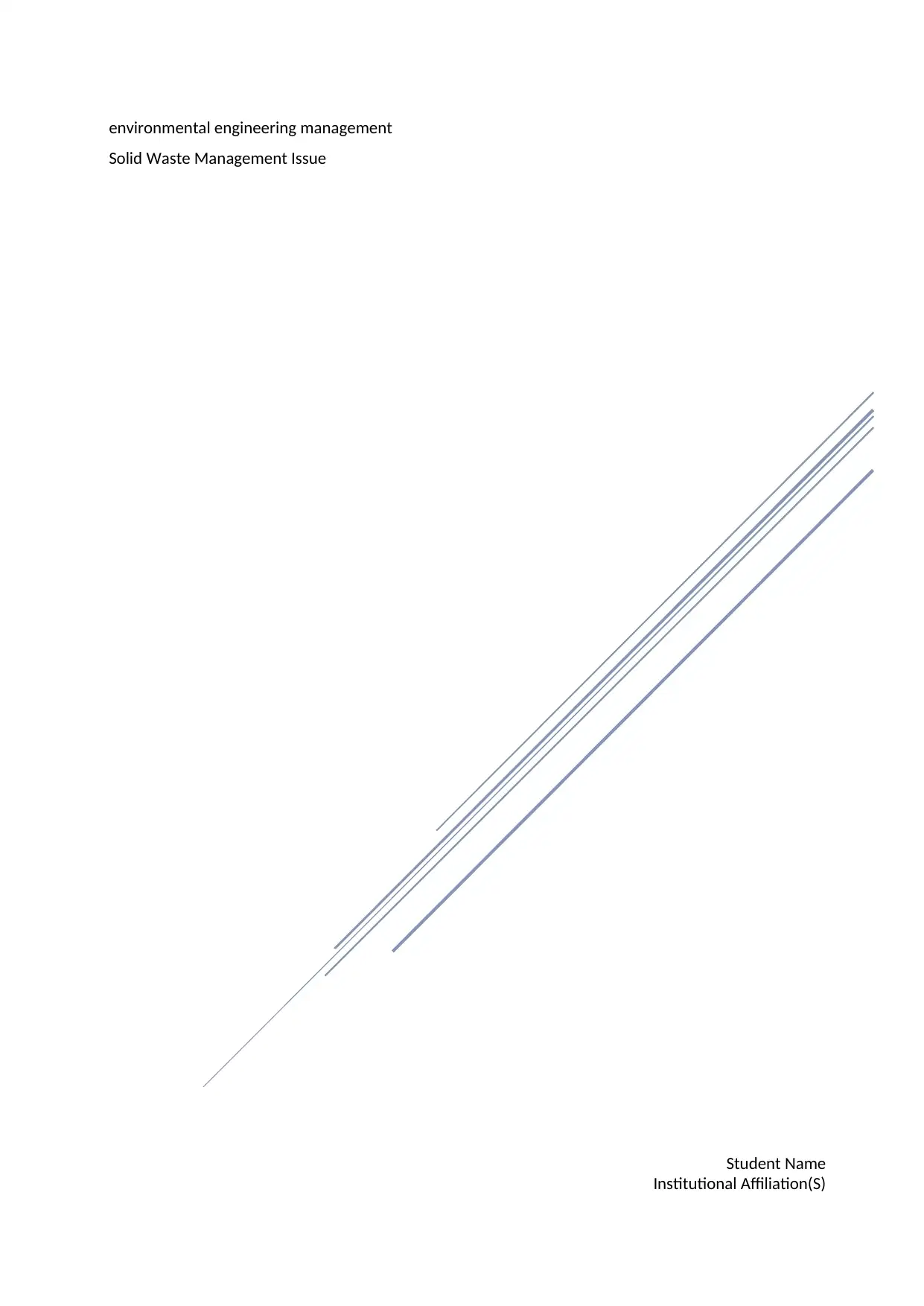
Student Name
Institutional Affiliation(S)
environmental engineering management
Solid Waste Management Issue
Institutional Affiliation(S)
environmental engineering management
Solid Waste Management Issue
Paraphrase This Document
Need a fresh take? Get an instant paraphrase of this document with our AI Paraphraser
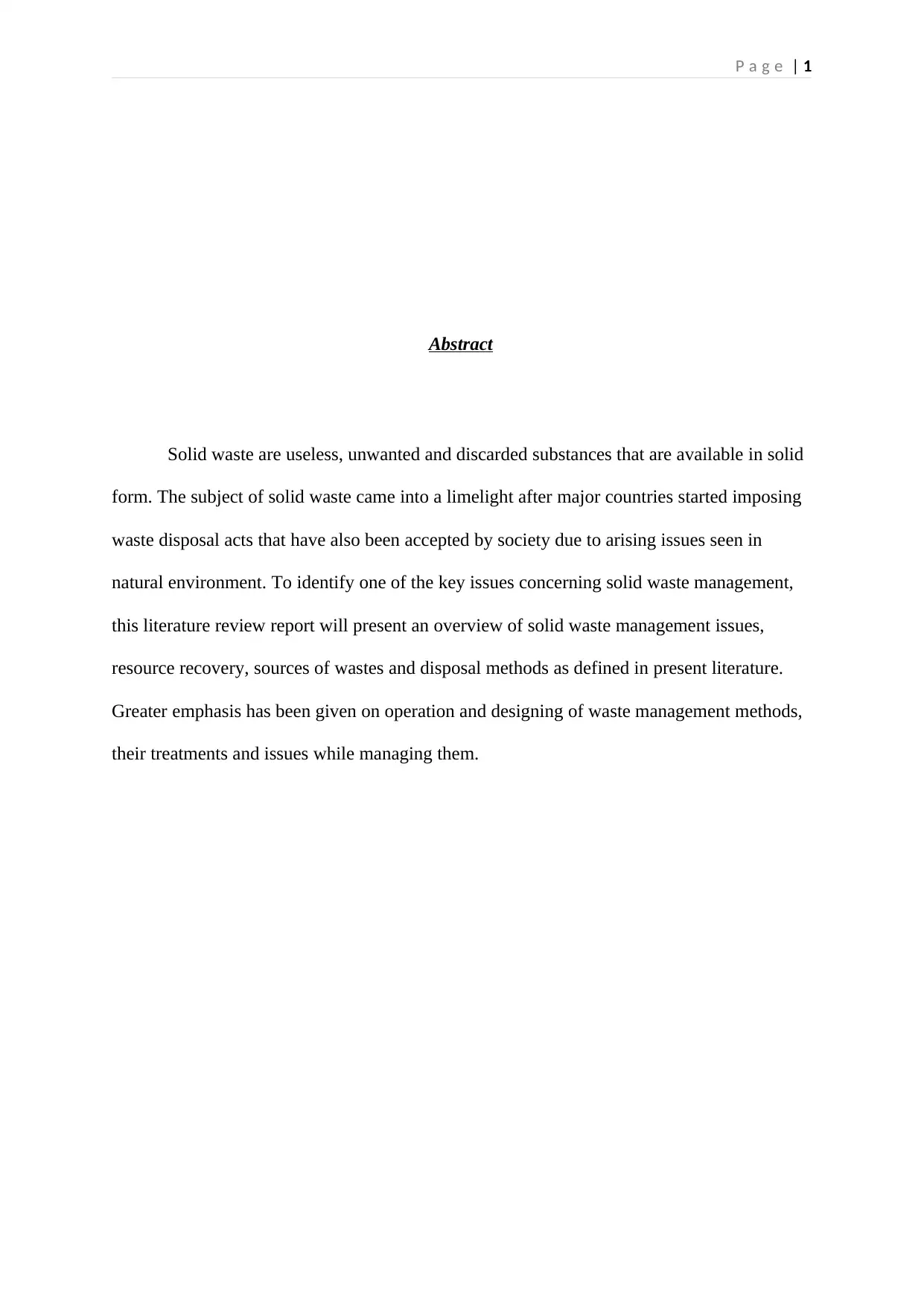
P a g e | 1
Abstract
Solid waste are useless, unwanted and discarded substances that are available in solid
form. The subject of solid waste came into a limelight after major countries started imposing
waste disposal acts that have also been accepted by society due to arising issues seen in
natural environment. To identify one of the key issues concerning solid waste management,
this literature review report will present an overview of solid waste management issues,
resource recovery, sources of wastes and disposal methods as defined in present literature.
Greater emphasis has been given on operation and designing of waste management methods,
their treatments and issues while managing them.
Abstract
Solid waste are useless, unwanted and discarded substances that are available in solid
form. The subject of solid waste came into a limelight after major countries started imposing
waste disposal acts that have also been accepted by society due to arising issues seen in
natural environment. To identify one of the key issues concerning solid waste management,
this literature review report will present an overview of solid waste management issues,
resource recovery, sources of wastes and disposal methods as defined in present literature.
Greater emphasis has been given on operation and designing of waste management methods,
their treatments and issues while managing them.
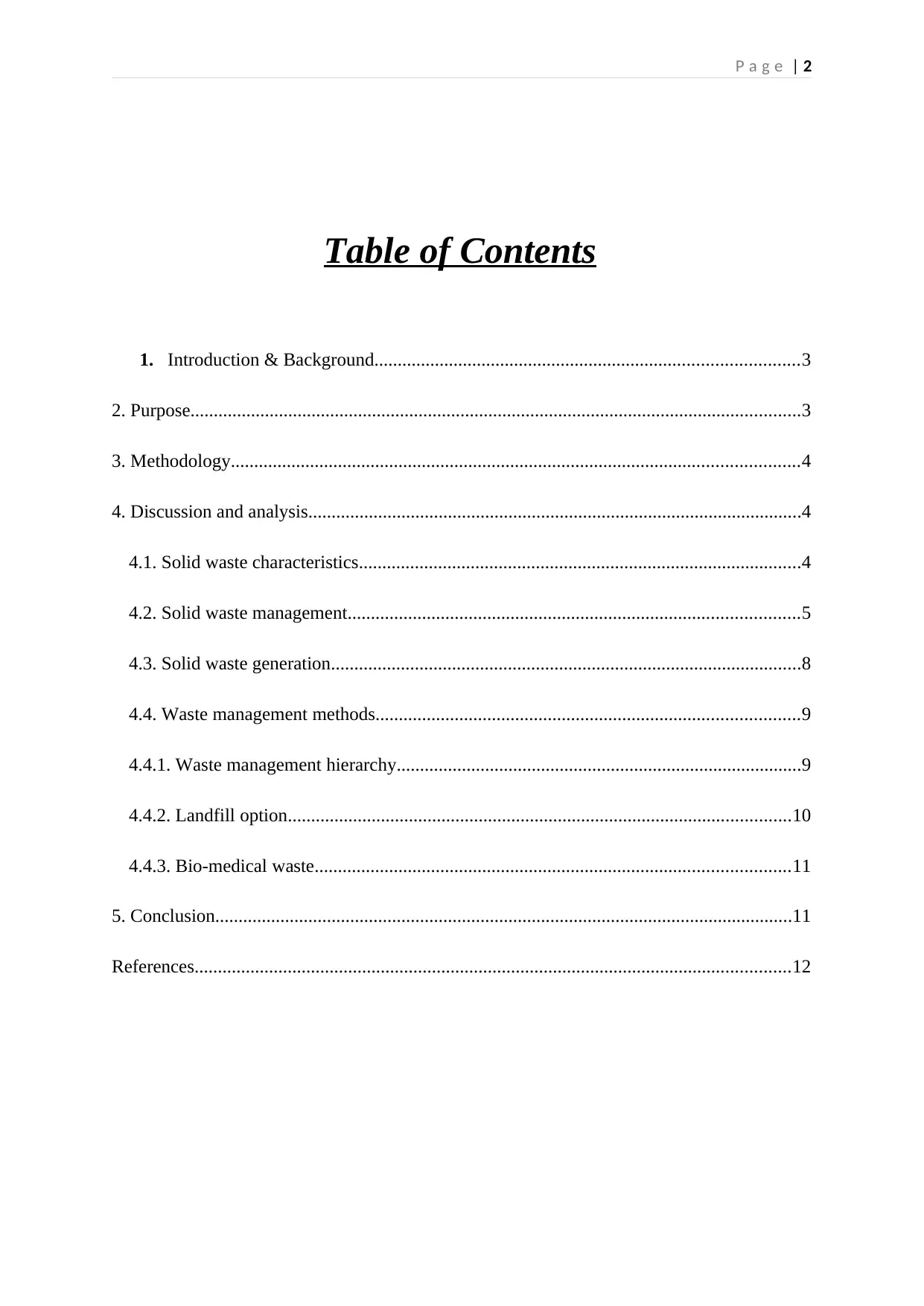
P a g e | 2
Table of Contents
1. Introduction & Background...........................................................................................3
2. Purpose...................................................................................................................................3
3. Methodology..........................................................................................................................4
4. Discussion and analysis..........................................................................................................4
4.1. Solid waste characteristics...............................................................................................4
4.2. Solid waste management.................................................................................................5
4.3. Solid waste generation.....................................................................................................8
4.4. Waste management methods...........................................................................................9
4.4.1. Waste management hierarchy.......................................................................................9
4.4.2. Landfill option............................................................................................................10
4.4.3. Bio-medical waste......................................................................................................11
5. Conclusion............................................................................................................................11
References................................................................................................................................12
Table of Contents
1. Introduction & Background...........................................................................................3
2. Purpose...................................................................................................................................3
3. Methodology..........................................................................................................................4
4. Discussion and analysis..........................................................................................................4
4.1. Solid waste characteristics...............................................................................................4
4.2. Solid waste management.................................................................................................5
4.3. Solid waste generation.....................................................................................................8
4.4. Waste management methods...........................................................................................9
4.4.1. Waste management hierarchy.......................................................................................9
4.4.2. Landfill option............................................................................................................10
4.4.3. Bio-medical waste......................................................................................................11
5. Conclusion............................................................................................................................11
References................................................................................................................................12
⊘ This is a preview!⊘
Do you want full access?
Subscribe today to unlock all pages.

Trusted by 1+ million students worldwide
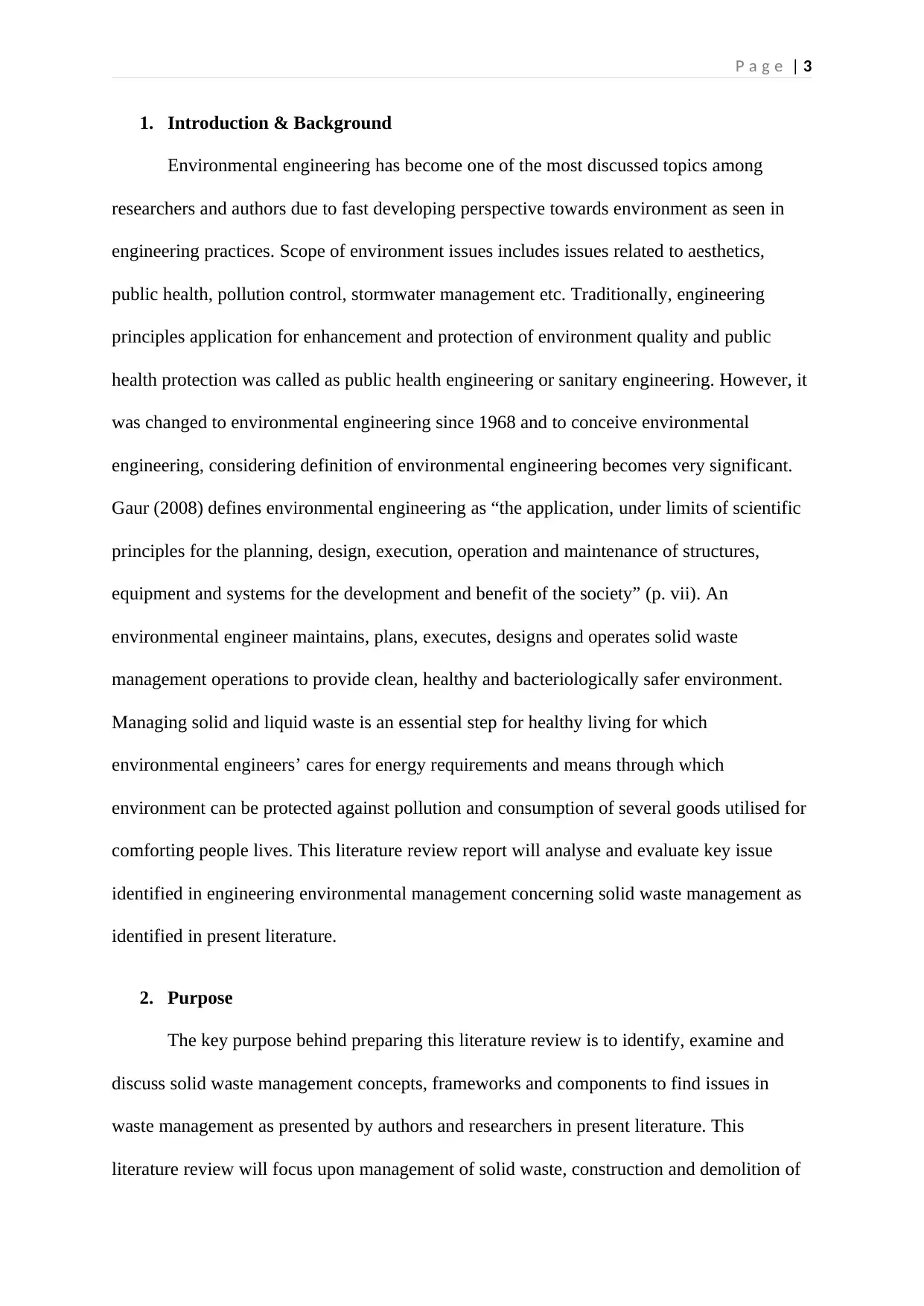
P a g e | 3
1. Introduction & Background
Environmental engineering has become one of the most discussed topics among
researchers and authors due to fast developing perspective towards environment as seen in
engineering practices. Scope of environment issues includes issues related to aesthetics,
public health, pollution control, stormwater management etc. Traditionally, engineering
principles application for enhancement and protection of environment quality and public
health protection was called as public health engineering or sanitary engineering. However, it
was changed to environmental engineering since 1968 and to conceive environmental
engineering, considering definition of environmental engineering becomes very significant.
Gaur (2008) defines environmental engineering as “the application, under limits of scientific
principles for the planning, design, execution, operation and maintenance of structures,
equipment and systems for the development and benefit of the society” (p. vii). An
environmental engineer maintains, plans, executes, designs and operates solid waste
management operations to provide clean, healthy and bacteriologically safer environment.
Managing solid and liquid waste is an essential step for healthy living for which
environmental engineers’ cares for energy requirements and means through which
environment can be protected against pollution and consumption of several goods utilised for
comforting people lives. This literature review report will analyse and evaluate key issue
identified in engineering environmental management concerning solid waste management as
identified in present literature.
2. Purpose
The key purpose behind preparing this literature review is to identify, examine and
discuss solid waste management concepts, frameworks and components to find issues in
waste management as presented by authors and researchers in present literature. This
literature review will focus upon management of solid waste, construction and demolition of
1. Introduction & Background
Environmental engineering has become one of the most discussed topics among
researchers and authors due to fast developing perspective towards environment as seen in
engineering practices. Scope of environment issues includes issues related to aesthetics,
public health, pollution control, stormwater management etc. Traditionally, engineering
principles application for enhancement and protection of environment quality and public
health protection was called as public health engineering or sanitary engineering. However, it
was changed to environmental engineering since 1968 and to conceive environmental
engineering, considering definition of environmental engineering becomes very significant.
Gaur (2008) defines environmental engineering as “the application, under limits of scientific
principles for the planning, design, execution, operation and maintenance of structures,
equipment and systems for the development and benefit of the society” (p. vii). An
environmental engineer maintains, plans, executes, designs and operates solid waste
management operations to provide clean, healthy and bacteriologically safer environment.
Managing solid and liquid waste is an essential step for healthy living for which
environmental engineers’ cares for energy requirements and means through which
environment can be protected against pollution and consumption of several goods utilised for
comforting people lives. This literature review report will analyse and evaluate key issue
identified in engineering environmental management concerning solid waste management as
identified in present literature.
2. Purpose
The key purpose behind preparing this literature review is to identify, examine and
discuss solid waste management concepts, frameworks and components to find issues in
waste management as presented by authors and researchers in present literature. This
literature review will focus upon management of solid waste, construction and demolition of
Paraphrase This Document
Need a fresh take? Get an instant paraphrase of this document with our AI Paraphraser
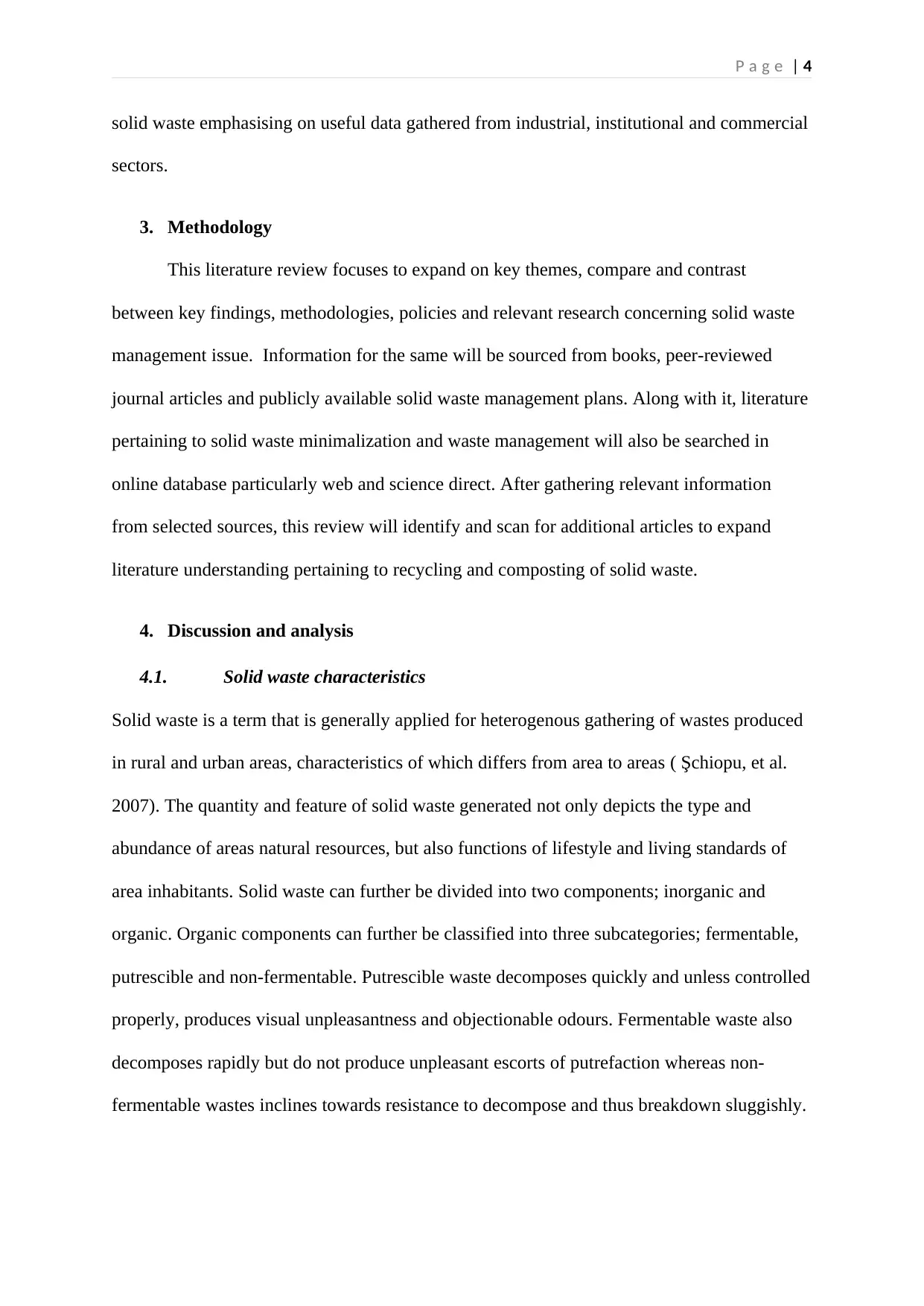
P a g e | 4
solid waste emphasising on useful data gathered from industrial, institutional and commercial
sectors.
3. Methodology
This literature review focuses to expand on key themes, compare and contrast
between key findings, methodologies, policies and relevant research concerning solid waste
management issue. Information for the same will be sourced from books, peer-reviewed
journal articles and publicly available solid waste management plans. Along with it, literature
pertaining to solid waste minimalization and waste management will also be searched in
online database particularly web and science direct. After gathering relevant information
from selected sources, this review will identify and scan for additional articles to expand
literature understanding pertaining to recycling and composting of solid waste.
4. Discussion and analysis
4.1. Solid waste characteristics
Solid waste is a term that is generally applied for heterogenous gathering of wastes produced
in rural and urban areas, characteristics of which differs from area to areas ( Şchiopu, et al.
2007). The quantity and feature of solid waste generated not only depicts the type and
abundance of areas natural resources, but also functions of lifestyle and living standards of
area inhabitants. Solid waste can further be divided into two components; inorganic and
organic. Organic components can further be classified into three subcategories; fermentable,
putrescible and non-fermentable. Putrescible waste decomposes quickly and unless controlled
properly, produces visual unpleasantness and objectionable odours. Fermentable waste also
decomposes rapidly but do not produce unpleasant escorts of putrefaction whereas non-
fermentable wastes inclines towards resistance to decompose and thus breakdown sluggishly.
solid waste emphasising on useful data gathered from industrial, institutional and commercial
sectors.
3. Methodology
This literature review focuses to expand on key themes, compare and contrast
between key findings, methodologies, policies and relevant research concerning solid waste
management issue. Information for the same will be sourced from books, peer-reviewed
journal articles and publicly available solid waste management plans. Along with it, literature
pertaining to solid waste minimalization and waste management will also be searched in
online database particularly web and science direct. After gathering relevant information
from selected sources, this review will identify and scan for additional articles to expand
literature understanding pertaining to recycling and composting of solid waste.
4. Discussion and analysis
4.1. Solid waste characteristics
Solid waste is a term that is generally applied for heterogenous gathering of wastes produced
in rural and urban areas, characteristics of which differs from area to areas ( Şchiopu, et al.
2007). The quantity and feature of solid waste generated not only depicts the type and
abundance of areas natural resources, but also functions of lifestyle and living standards of
area inhabitants. Solid waste can further be divided into two components; inorganic and
organic. Organic components can further be classified into three subcategories; fermentable,
putrescible and non-fermentable. Putrescible waste decomposes quickly and unless controlled
properly, produces visual unpleasantness and objectionable odours. Fermentable waste also
decomposes rapidly but do not produce unpleasant escorts of putrefaction whereas non-
fermentable wastes inclines towards resistance to decompose and thus breakdown sluggishly.
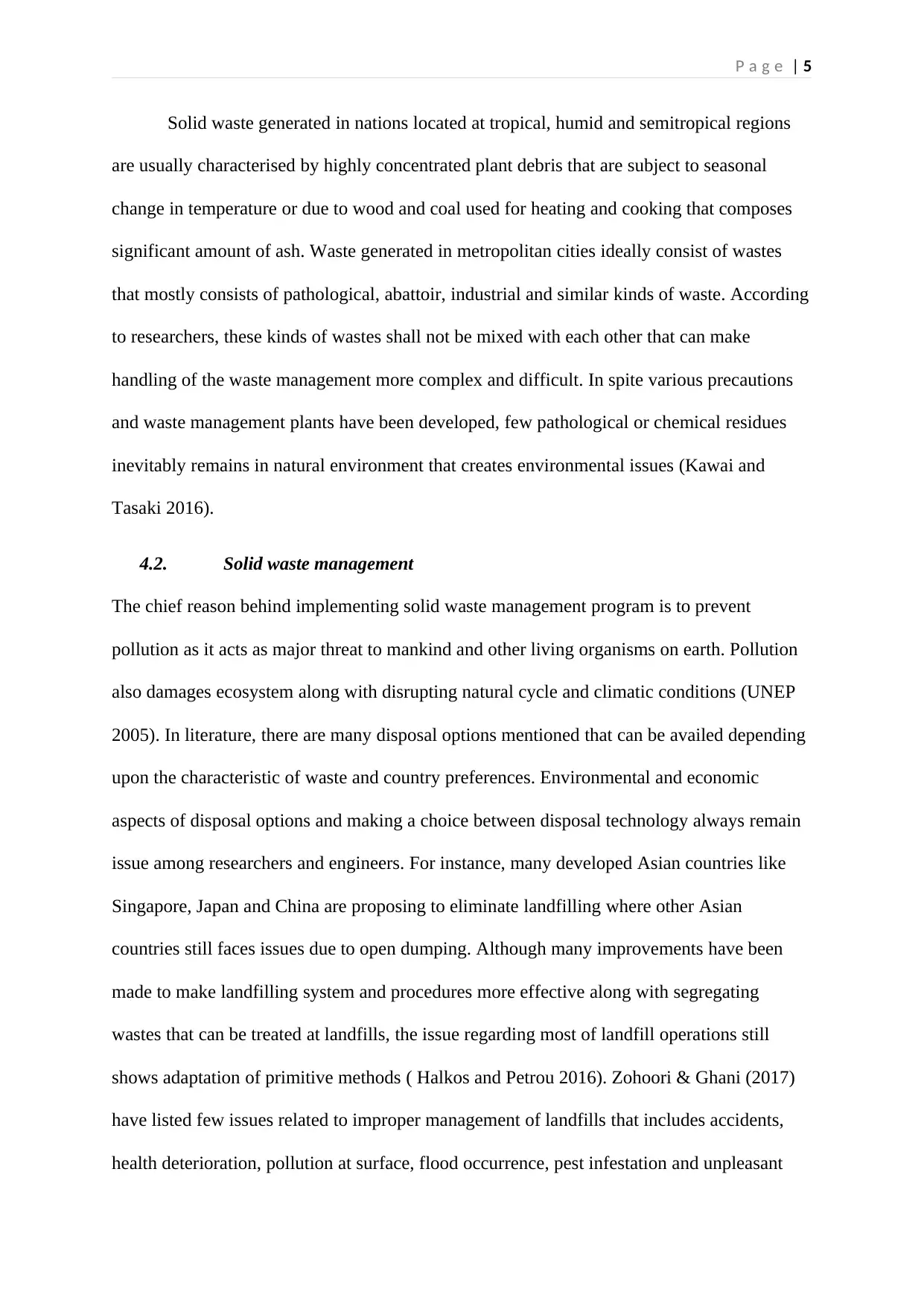
P a g e | 5
Solid waste generated in nations located at tropical, humid and semitropical regions
are usually characterised by highly concentrated plant debris that are subject to seasonal
change in temperature or due to wood and coal used for heating and cooking that composes
significant amount of ash. Waste generated in metropolitan cities ideally consist of wastes
that mostly consists of pathological, abattoir, industrial and similar kinds of waste. According
to researchers, these kinds of wastes shall not be mixed with each other that can make
handling of the waste management more complex and difficult. In spite various precautions
and waste management plants have been developed, few pathological or chemical residues
inevitably remains in natural environment that creates environmental issues (Kawai and
Tasaki 2016).
4.2. Solid waste management
The chief reason behind implementing solid waste management program is to prevent
pollution as it acts as major threat to mankind and other living organisms on earth. Pollution
also damages ecosystem along with disrupting natural cycle and climatic conditions (UNEP
2005). In literature, there are many disposal options mentioned that can be availed depending
upon the characteristic of waste and country preferences. Environmental and economic
aspects of disposal options and making a choice between disposal technology always remain
issue among researchers and engineers. For instance, many developed Asian countries like
Singapore, Japan and China are proposing to eliminate landfilling where other Asian
countries still faces issues due to open dumping. Although many improvements have been
made to make landfilling system and procedures more effective along with segregating
wastes that can be treated at landfills, the issue regarding most of landfill operations still
shows adaptation of primitive methods ( Halkos and Petrou 2016). Zohoori & Ghani (2017)
have listed few issues related to improper management of landfills that includes accidents,
health deterioration, pollution at surface, flood occurrence, pest infestation and unpleasant
Solid waste generated in nations located at tropical, humid and semitropical regions
are usually characterised by highly concentrated plant debris that are subject to seasonal
change in temperature or due to wood and coal used for heating and cooking that composes
significant amount of ash. Waste generated in metropolitan cities ideally consist of wastes
that mostly consists of pathological, abattoir, industrial and similar kinds of waste. According
to researchers, these kinds of wastes shall not be mixed with each other that can make
handling of the waste management more complex and difficult. In spite various precautions
and waste management plants have been developed, few pathological or chemical residues
inevitably remains in natural environment that creates environmental issues (Kawai and
Tasaki 2016).
4.2. Solid waste management
The chief reason behind implementing solid waste management program is to prevent
pollution as it acts as major threat to mankind and other living organisms on earth. Pollution
also damages ecosystem along with disrupting natural cycle and climatic conditions (UNEP
2005). In literature, there are many disposal options mentioned that can be availed depending
upon the characteristic of waste and country preferences. Environmental and economic
aspects of disposal options and making a choice between disposal technology always remain
issue among researchers and engineers. For instance, many developed Asian countries like
Singapore, Japan and China are proposing to eliminate landfilling where other Asian
countries still faces issues due to open dumping. Although many improvements have been
made to make landfilling system and procedures more effective along with segregating
wastes that can be treated at landfills, the issue regarding most of landfill operations still
shows adaptation of primitive methods ( Halkos and Petrou 2016). Zohoori & Ghani (2017)
have listed few issues related to improper management of landfills that includes accidents,
health deterioration, pollution at surface, flood occurrence, pest infestation and unpleasant
⊘ This is a preview!⊘
Do you want full access?
Subscribe today to unlock all pages.

Trusted by 1+ million students worldwide
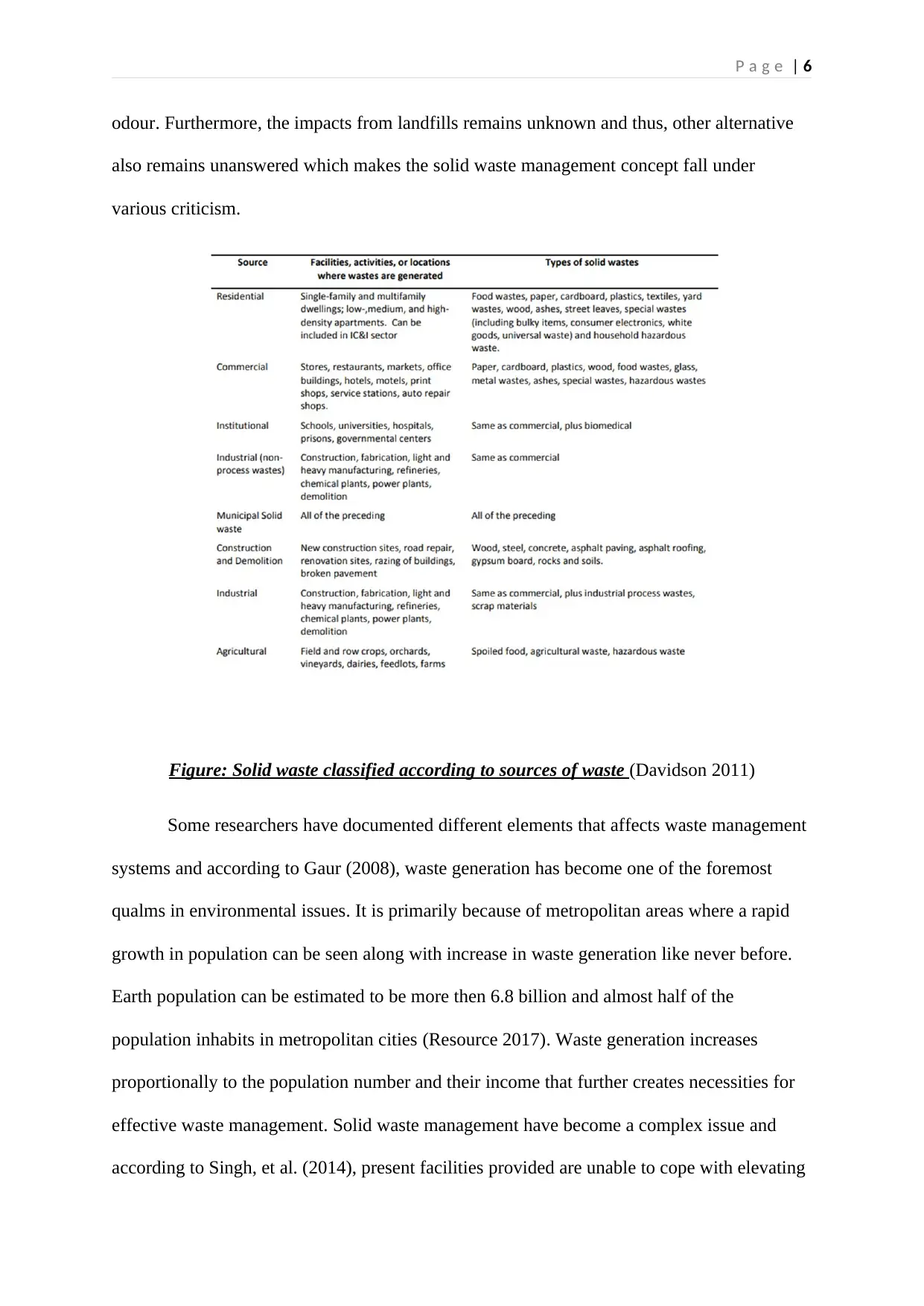
P a g e | 6
odour. Furthermore, the impacts from landfills remains unknown and thus, other alternative
also remains unanswered which makes the solid waste management concept fall under
various criticism.
Figure: Solid waste classified according to sources of waste (Davidson 2011)
Some researchers have documented different elements that affects waste management
systems and according to Gaur (2008), waste generation has become one of the foremost
qualms in environmental issues. It is primarily because of metropolitan areas where a rapid
growth in population can be seen along with increase in waste generation like never before.
Earth population can be estimated to be more then 6.8 billion and almost half of the
population inhabits in metropolitan cities (Resource 2017). Waste generation increases
proportionally to the population number and their income that further creates necessities for
effective waste management. Solid waste management have become a complex issue and
according to Singh, et al. (2014), present facilities provided are unable to cope with elevating
odour. Furthermore, the impacts from landfills remains unknown and thus, other alternative
also remains unanswered which makes the solid waste management concept fall under
various criticism.
Figure: Solid waste classified according to sources of waste (Davidson 2011)
Some researchers have documented different elements that affects waste management
systems and according to Gaur (2008), waste generation has become one of the foremost
qualms in environmental issues. It is primarily because of metropolitan areas where a rapid
growth in population can be seen along with increase in waste generation like never before.
Earth population can be estimated to be more then 6.8 billion and almost half of the
population inhabits in metropolitan cities (Resource 2017). Waste generation increases
proportionally to the population number and their income that further creates necessities for
effective waste management. Solid waste management have become a complex issue and
according to Singh, et al. (2014), present facilities provided are unable to cope with elevating
Paraphrase This Document
Need a fresh take? Get an instant paraphrase of this document with our AI Paraphraser
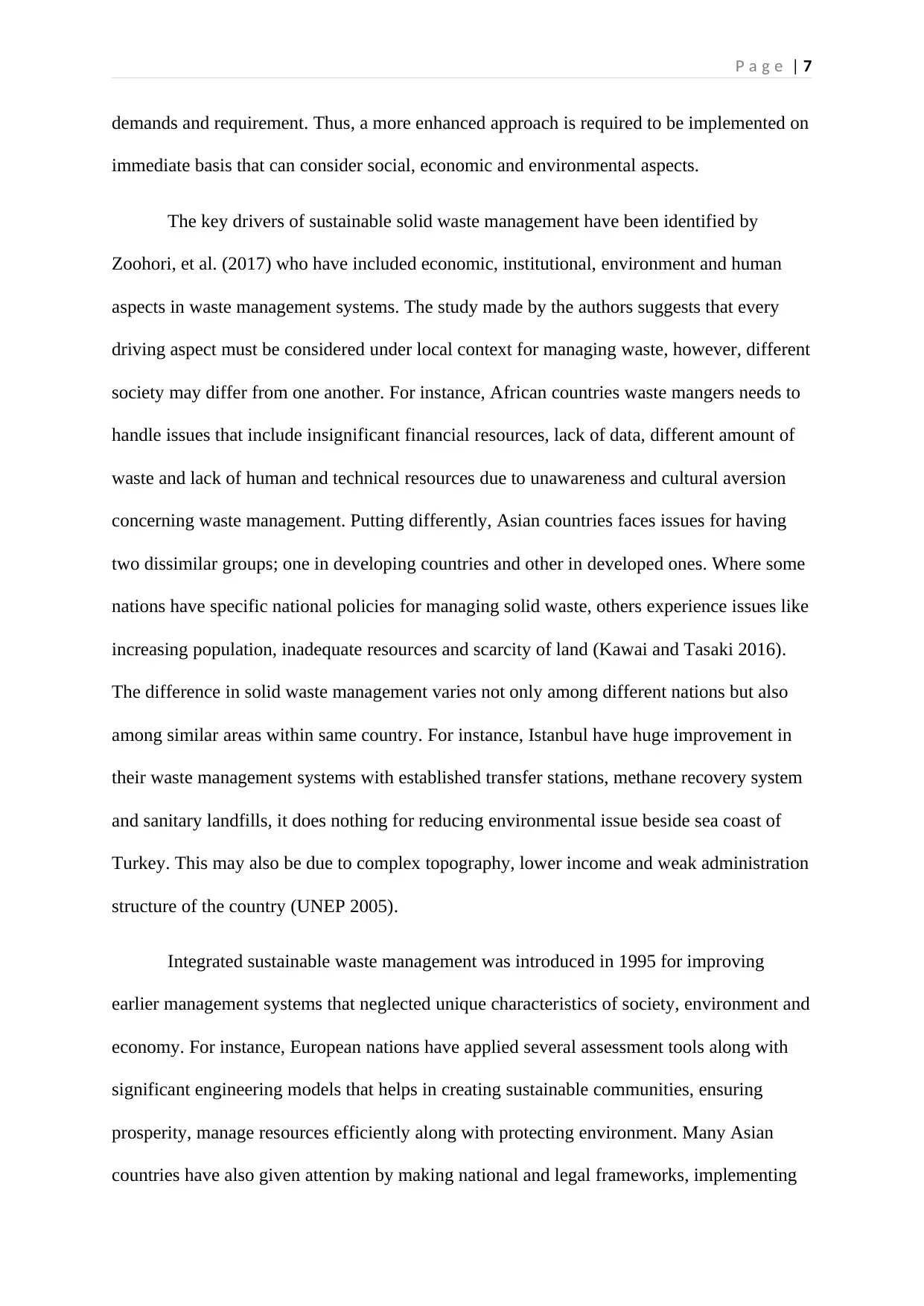
P a g e | 7
demands and requirement. Thus, a more enhanced approach is required to be implemented on
immediate basis that can consider social, economic and environmental aspects.
The key drivers of sustainable solid waste management have been identified by
Zoohori, et al. (2017) who have included economic, institutional, environment and human
aspects in waste management systems. The study made by the authors suggests that every
driving aspect must be considered under local context for managing waste, however, different
society may differ from one another. For instance, African countries waste mangers needs to
handle issues that include insignificant financial resources, lack of data, different amount of
waste and lack of human and technical resources due to unawareness and cultural aversion
concerning waste management. Putting differently, Asian countries faces issues for having
two dissimilar groups; one in developing countries and other in developed ones. Where some
nations have specific national policies for managing solid waste, others experience issues like
increasing population, inadequate resources and scarcity of land (Kawai and Tasaki 2016).
The difference in solid waste management varies not only among different nations but also
among similar areas within same country. For instance, Istanbul have huge improvement in
their waste management systems with established transfer stations, methane recovery system
and sanitary landfills, it does nothing for reducing environmental issue beside sea coast of
Turkey. This may also be due to complex topography, lower income and weak administration
structure of the country (UNEP 2005).
Integrated sustainable waste management was introduced in 1995 for improving
earlier management systems that neglected unique characteristics of society, environment and
economy. For instance, European nations have applied several assessment tools along with
significant engineering models that helps in creating sustainable communities, ensuring
prosperity, manage resources efficiently along with protecting environment. Many Asian
countries have also given attention by making national and legal frameworks, implementing
demands and requirement. Thus, a more enhanced approach is required to be implemented on
immediate basis that can consider social, economic and environmental aspects.
The key drivers of sustainable solid waste management have been identified by
Zoohori, et al. (2017) who have included economic, institutional, environment and human
aspects in waste management systems. The study made by the authors suggests that every
driving aspect must be considered under local context for managing waste, however, different
society may differ from one another. For instance, African countries waste mangers needs to
handle issues that include insignificant financial resources, lack of data, different amount of
waste and lack of human and technical resources due to unawareness and cultural aversion
concerning waste management. Putting differently, Asian countries faces issues for having
two dissimilar groups; one in developing countries and other in developed ones. Where some
nations have specific national policies for managing solid waste, others experience issues like
increasing population, inadequate resources and scarcity of land (Kawai and Tasaki 2016).
The difference in solid waste management varies not only among different nations but also
among similar areas within same country. For instance, Istanbul have huge improvement in
their waste management systems with established transfer stations, methane recovery system
and sanitary landfills, it does nothing for reducing environmental issue beside sea coast of
Turkey. This may also be due to complex topography, lower income and weak administration
structure of the country (UNEP 2005).
Integrated sustainable waste management was introduced in 1995 for improving
earlier management systems that neglected unique characteristics of society, environment and
economy. For instance, European nations have applied several assessment tools along with
significant engineering models that helps in creating sustainable communities, ensuring
prosperity, manage resources efficiently along with protecting environment. Many Asian
countries have also given attention by making national and legal frameworks, implementing
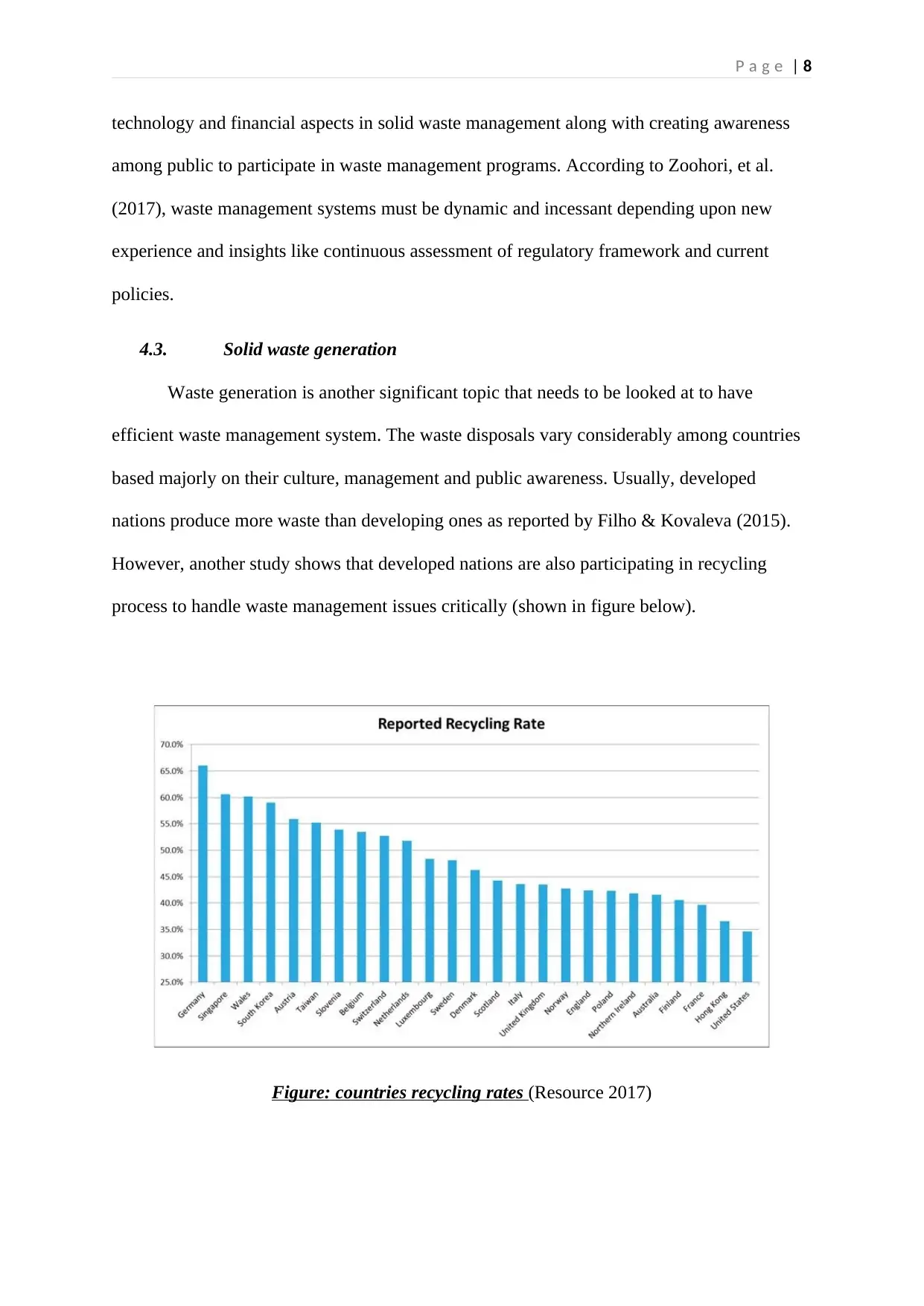
P a g e | 8
technology and financial aspects in solid waste management along with creating awareness
among public to participate in waste management programs. According to Zoohori, et al.
(2017), waste management systems must be dynamic and incessant depending upon new
experience and insights like continuous assessment of regulatory framework and current
policies.
4.3. Solid waste generation
Waste generation is another significant topic that needs to be looked at to have
efficient waste management system. The waste disposals vary considerably among countries
based majorly on their culture, management and public awareness. Usually, developed
nations produce more waste than developing ones as reported by Filho & Kovaleva (2015).
However, another study shows that developed nations are also participating in recycling
process to handle waste management issues critically (shown in figure below).
Figure: countries recycling rates (Resource 2017)
technology and financial aspects in solid waste management along with creating awareness
among public to participate in waste management programs. According to Zoohori, et al.
(2017), waste management systems must be dynamic and incessant depending upon new
experience and insights like continuous assessment of regulatory framework and current
policies.
4.3. Solid waste generation
Waste generation is another significant topic that needs to be looked at to have
efficient waste management system. The waste disposals vary considerably among countries
based majorly on their culture, management and public awareness. Usually, developed
nations produce more waste than developing ones as reported by Filho & Kovaleva (2015).
However, another study shows that developed nations are also participating in recycling
process to handle waste management issues critically (shown in figure below).
Figure: countries recycling rates (Resource 2017)
⊘ This is a preview!⊘
Do you want full access?
Subscribe today to unlock all pages.

Trusted by 1+ million students worldwide
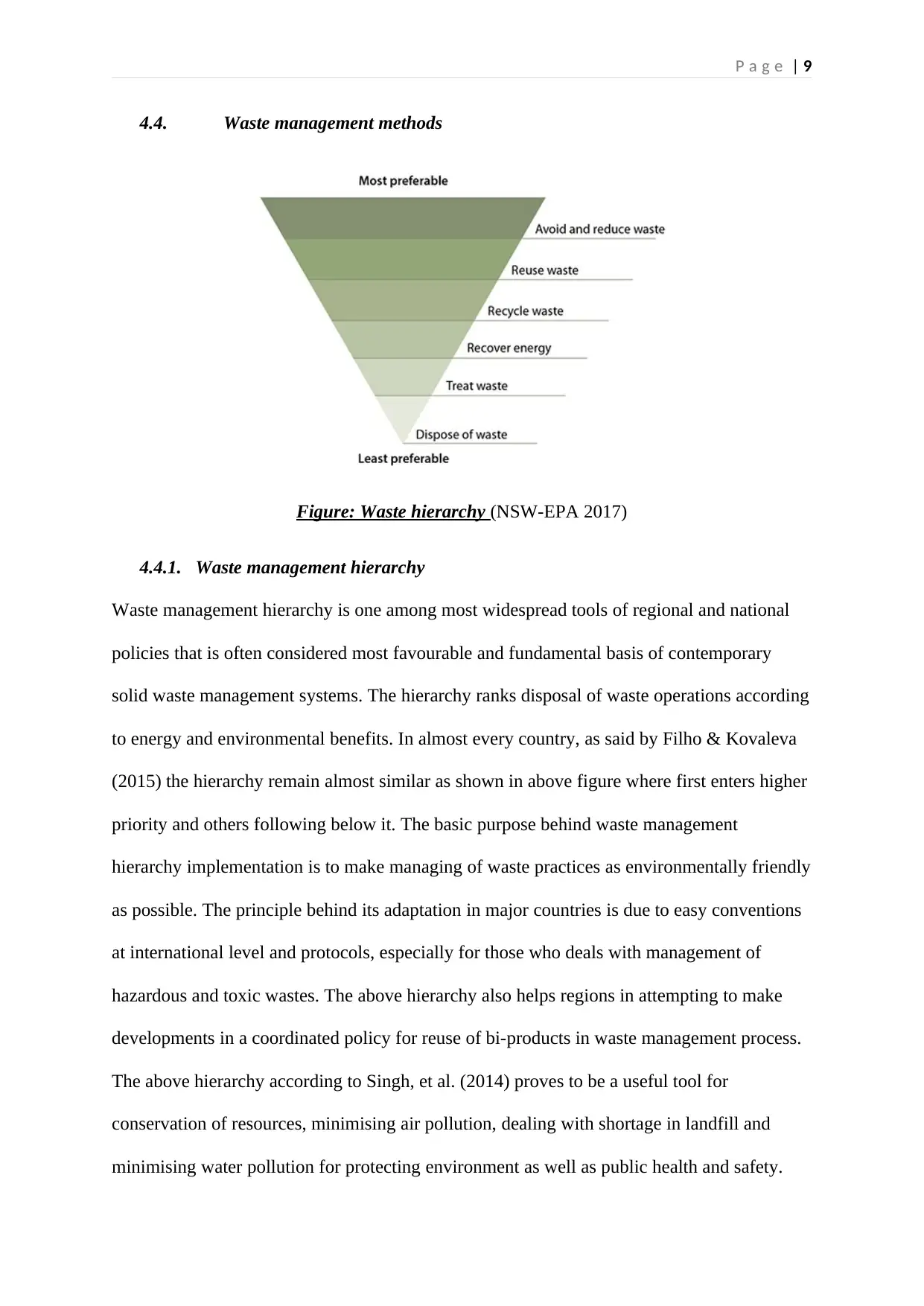
P a g e | 9
4.4. Waste management methods
Figure: Waste hierarchy (NSW-EPA 2017)
4.4.1. Waste management hierarchy
Waste management hierarchy is one among most widespread tools of regional and national
policies that is often considered most favourable and fundamental basis of contemporary
solid waste management systems. The hierarchy ranks disposal of waste operations according
to energy and environmental benefits. In almost every country, as said by Filho & Kovaleva
(2015) the hierarchy remain almost similar as shown in above figure where first enters higher
priority and others following below it. The basic purpose behind waste management
hierarchy implementation is to make managing of waste practices as environmentally friendly
as possible. The principle behind its adaptation in major countries is due to easy conventions
at international level and protocols, especially for those who deals with management of
hazardous and toxic wastes. The above hierarchy also helps regions in attempting to make
developments in a coordinated policy for reuse of bi-products in waste management process.
The above hierarchy according to Singh, et al. (2014) proves to be a useful tool for
conservation of resources, minimising air pollution, dealing with shortage in landfill and
minimising water pollution for protecting environment as well as public health and safety.
4.4. Waste management methods
Figure: Waste hierarchy (NSW-EPA 2017)
4.4.1. Waste management hierarchy
Waste management hierarchy is one among most widespread tools of regional and national
policies that is often considered most favourable and fundamental basis of contemporary
solid waste management systems. The hierarchy ranks disposal of waste operations according
to energy and environmental benefits. In almost every country, as said by Filho & Kovaleva
(2015) the hierarchy remain almost similar as shown in above figure where first enters higher
priority and others following below it. The basic purpose behind waste management
hierarchy implementation is to make managing of waste practices as environmentally friendly
as possible. The principle behind its adaptation in major countries is due to easy conventions
at international level and protocols, especially for those who deals with management of
hazardous and toxic wastes. The above hierarchy also helps regions in attempting to make
developments in a coordinated policy for reuse of bi-products in waste management process.
The above hierarchy according to Singh, et al. (2014) proves to be a useful tool for
conservation of resources, minimising air pollution, dealing with shortage in landfill and
minimising water pollution for protecting environment as well as public health and safety.
Paraphrase This Document
Need a fresh take? Get an instant paraphrase of this document with our AI Paraphraser
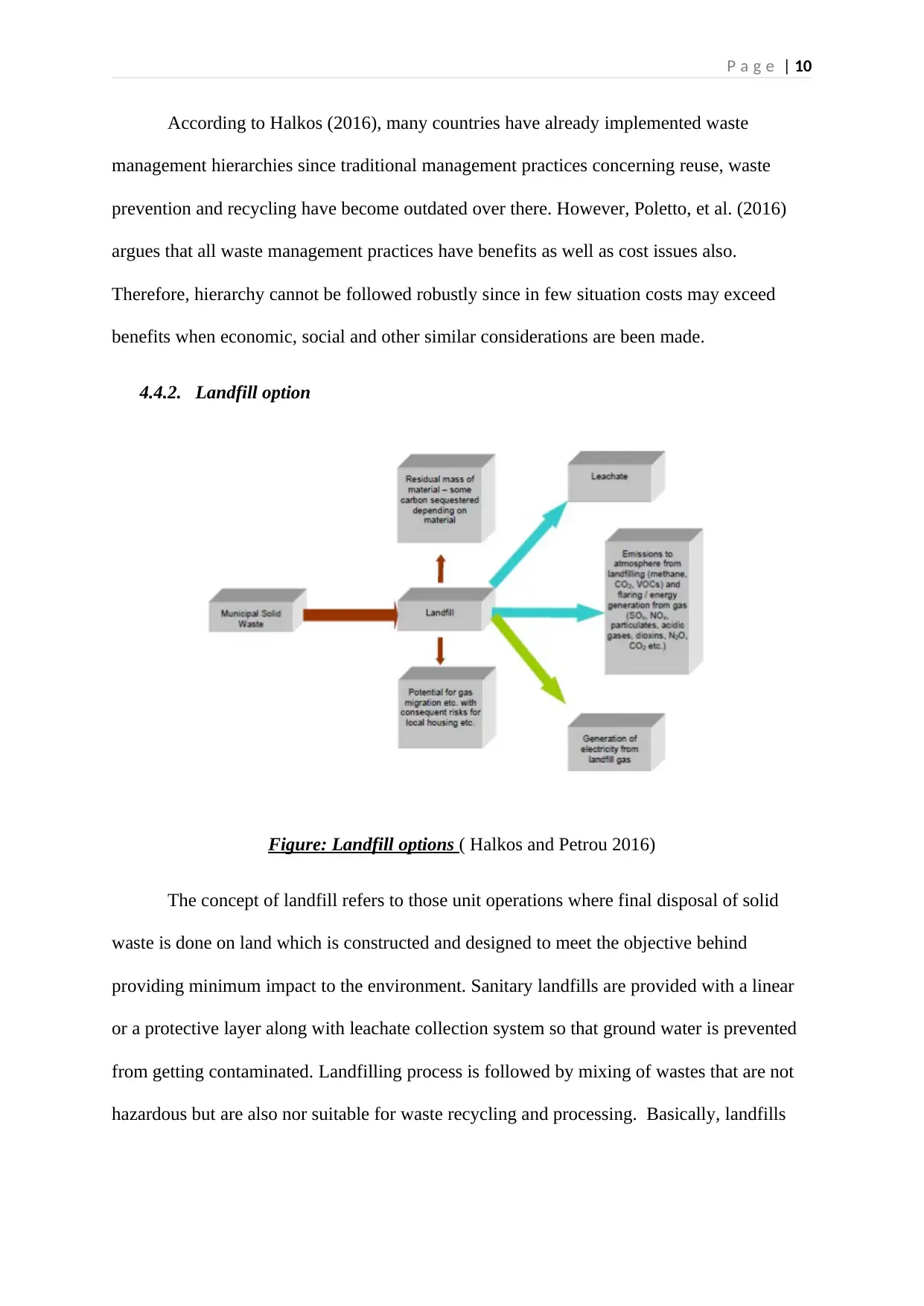
P a g e | 10
According to Halkos (2016), many countries have already implemented waste
management hierarchies since traditional management practices concerning reuse, waste
prevention and recycling have become outdated over there. However, Poletto, et al. (2016)
argues that all waste management practices have benefits as well as cost issues also.
Therefore, hierarchy cannot be followed robustly since in few situation costs may exceed
benefits when economic, social and other similar considerations are been made.
4.4.2. Landfill option
Figure: Landfill options ( Halkos and Petrou 2016)
The concept of landfill refers to those unit operations where final disposal of solid
waste is done on land which is constructed and designed to meet the objective behind
providing minimum impact to the environment. Sanitary landfills are provided with a linear
or a protective layer along with leachate collection system so that ground water is prevented
from getting contaminated. Landfilling process is followed by mixing of wastes that are not
hazardous but are also nor suitable for waste recycling and processing. Basically, landfills
According to Halkos (2016), many countries have already implemented waste
management hierarchies since traditional management practices concerning reuse, waste
prevention and recycling have become outdated over there. However, Poletto, et al. (2016)
argues that all waste management practices have benefits as well as cost issues also.
Therefore, hierarchy cannot be followed robustly since in few situation costs may exceed
benefits when economic, social and other similar considerations are been made.
4.4.2. Landfill option
Figure: Landfill options ( Halkos and Petrou 2016)
The concept of landfill refers to those unit operations where final disposal of solid
waste is done on land which is constructed and designed to meet the objective behind
providing minimum impact to the environment. Sanitary landfills are provided with a linear
or a protective layer along with leachate collection system so that ground water is prevented
from getting contaminated. Landfilling process is followed by mixing of wastes that are not
hazardous but are also nor suitable for waste recycling and processing. Basically, landfills
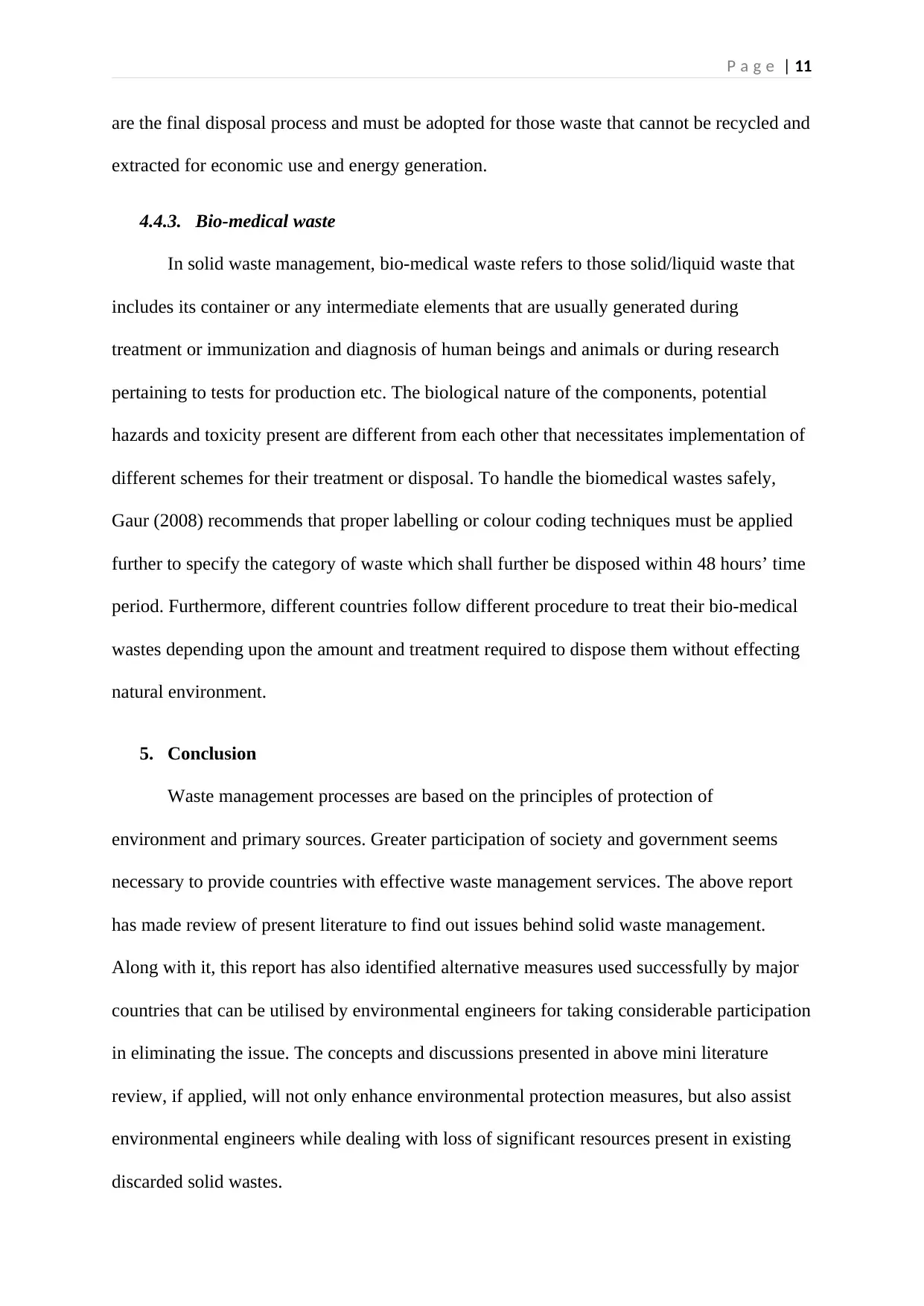
P a g e | 11
are the final disposal process and must be adopted for those waste that cannot be recycled and
extracted for economic use and energy generation.
4.4.3. Bio-medical waste
In solid waste management, bio-medical waste refers to those solid/liquid waste that
includes its container or any intermediate elements that are usually generated during
treatment or immunization and diagnosis of human beings and animals or during research
pertaining to tests for production etc. The biological nature of the components, potential
hazards and toxicity present are different from each other that necessitates implementation of
different schemes for their treatment or disposal. To handle the biomedical wastes safely,
Gaur (2008) recommends that proper labelling or colour coding techniques must be applied
further to specify the category of waste which shall further be disposed within 48 hours’ time
period. Furthermore, different countries follow different procedure to treat their bio-medical
wastes depending upon the amount and treatment required to dispose them without effecting
natural environment.
5. Conclusion
Waste management processes are based on the principles of protection of
environment and primary sources. Greater participation of society and government seems
necessary to provide countries with effective waste management services. The above report
has made review of present literature to find out issues behind solid waste management.
Along with it, this report has also identified alternative measures used successfully by major
countries that can be utilised by environmental engineers for taking considerable participation
in eliminating the issue. The concepts and discussions presented in above mini literature
review, if applied, will not only enhance environmental protection measures, but also assist
environmental engineers while dealing with loss of significant resources present in existing
discarded solid wastes.
are the final disposal process and must be adopted for those waste that cannot be recycled and
extracted for economic use and energy generation.
4.4.3. Bio-medical waste
In solid waste management, bio-medical waste refers to those solid/liquid waste that
includes its container or any intermediate elements that are usually generated during
treatment or immunization and diagnosis of human beings and animals or during research
pertaining to tests for production etc. The biological nature of the components, potential
hazards and toxicity present are different from each other that necessitates implementation of
different schemes for their treatment or disposal. To handle the biomedical wastes safely,
Gaur (2008) recommends that proper labelling or colour coding techniques must be applied
further to specify the category of waste which shall further be disposed within 48 hours’ time
period. Furthermore, different countries follow different procedure to treat their bio-medical
wastes depending upon the amount and treatment required to dispose them without effecting
natural environment.
5. Conclusion
Waste management processes are based on the principles of protection of
environment and primary sources. Greater participation of society and government seems
necessary to provide countries with effective waste management services. The above report
has made review of present literature to find out issues behind solid waste management.
Along with it, this report has also identified alternative measures used successfully by major
countries that can be utilised by environmental engineers for taking considerable participation
in eliminating the issue. The concepts and discussions presented in above mini literature
review, if applied, will not only enhance environmental protection measures, but also assist
environmental engineers while dealing with loss of significant resources present in existing
discarded solid wastes.
⊘ This is a preview!⊘
Do you want full access?
Subscribe today to unlock all pages.

Trusted by 1+ million students worldwide
1 out of 14
Related Documents
Your All-in-One AI-Powered Toolkit for Academic Success.
+13062052269
info@desklib.com
Available 24*7 on WhatsApp / Email
![[object Object]](/_next/static/media/star-bottom.7253800d.svg)
Unlock your academic potential
Copyright © 2020–2025 A2Z Services. All Rights Reserved. Developed and managed by ZUCOL.





